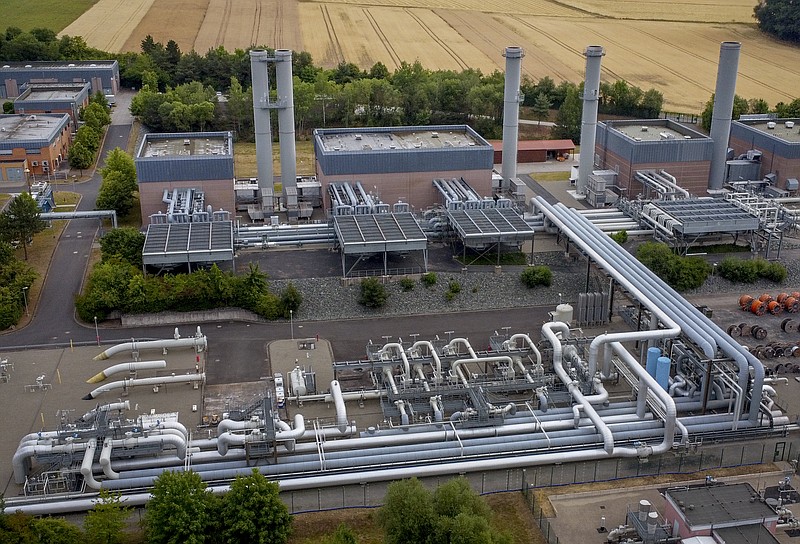 FILE - The gas storage plant Reckrod is pictured near Eiterfeld, central Germany, Thursday, July 14, 2022, after the Nord Stream 1 pipeline was shut down due to maintenance. European Union governments agreed Tuesday, July 26, 2022 to ration natural gas this winter to protect themselves against any further supply cuts by Russia as Moscow pursues its invasion of Ukraine. (AP Photo/Michael Probst, File)
FILE - The gas storage plant Reckrod is pictured near Eiterfeld, central Germany, Thursday, July 14, 2022, after the Nord Stream 1 pipeline was shut down due to maintenance. European Union governments agreed Tuesday, July 26, 2022 to ration natural gas this winter to protect themselves against any further supply cuts by Russia as Moscow pursues its invasion of Ukraine. (AP Photo/Michael Probst, File)The brutal invasion of Ukraine by Vladimir Putin and the forceful response from the West has served to highlight a huge problem of Europe's own making: excessive dependency upon Russia for its natural gas. The European Union is reducing consumption to rely less on Russia and to build a stockpile for the winter while it attempts to secure longer-term supplies from more reliable partners, but without doubt, the transition will be painful.
As the world's largest exporter of natural gas, the United States has ample reserves to offset Russian supplies and American producers are eager to do so. The fly in the ointment is that America has just a few facilities for liquifying gas for shipment, most of the existing capacity is already contracted to current customers, and building a new liquefaction plant to export the gas takes three to five years once the permits are granted (which takes another two years). Uncle Sam has plenty of gas, but it's going to take a while before it makes a substantial difference to Europe.
Germany, as the de facto leader and largest economy in the EU, made what has proven to be two serious miscalculations earlier this century. First in 2002, Chancellor Gerhard Schroeder announced that the country's 17 nuclear power plants would be gradually phased out. In 2011, Angela Merkel succumbed to pressure from the Green party members in her government's coalition to accelerate the decommissioning to the end of 2022. Today only three plants remain operational, all of which are due for mothballing in December.
The other big gamble taken by Germany and the rest of the EU was a deepening of economic ties with Russia, including increasing the amount of natural gas purchased from the former Soviet Union. These failed bets have rendered Europe dangerously dependent on Putin at the most perilous moment of this century. In 2021, the EU purchased 40% of its gas from Russia and Germany over 50%. This has left Western Europe exceptionally vulnerable to Putin's caprice and is in fact helping to finance the invasion and devastation of Ukraine.
Meanwhile across the pond, America is swimming in gas. It was not always so. Following deregulation of electrical generation in the late 1990s, dozens of gas-fired generating plants sprang up that quickly created a critical gas shortage and caused prices to quintuple. Then along came the revolution in horizontal drilling and hydraulic fracturing that freed up massive amounts of previously inaccessible oil and gas. This unexpected bounty soon propelled the US from being a net importer in 2017 to the world's largest exporter of natural gas by 2021.
But moving large volumes of gas requires an additional complex and costly process: turning the gas into a liquid for shipping. The process, known as liquefaction, involves a multi-step process of cooling the gas to minus 260 degrees Fahrenheit, at which point it becomes a liquid that can efficiently be loaded on transport ships and moved around the globe. This refrigerated product is referred to as Liquified Natural Gas or LNG and is 1/600th the volume of gas at room temperature, making long-distance gas transportation feasible. Visualize a 55-gallon drum of natural gas squeezed down into a liquid that would fit in a beer can.
Commercially viable liquification or liquefaction was first developed in 1873 by German scientist Karl von Linde, whose name lives on today in the Linde Corporation. The earliest transport vessel was a converted WWII Liberty Ship rechristened the "Methane Pioneer" which carried its first load of LNG to England in 1959. The largest LNG transport ships today carry about 48 times as much gas as the Methane Pioneer, enough energy to heat 50,000 average homes for a year.
The first US facility to export LNG in 2016 was the Cheniere Energy Sabine Pass liquefaction terminal on the Louisiana gulf coast. Ironically emblematic of the radical shift in US energy assets, the Sabine Pass facility was originally built in 2008 to receive imported gas from abroad.
There are currently eight liquefaction terminals or "trains" in operation, with three more under construction and 12 that have cleared the regulatory hurdles to start construction. That means that it will be at least 2024 or 2025 before significant additional export capacity becomes available to supply the European economy.
Most of the current capacity is under contract, but some shipments have been diverted to Europe or have been resold to European customers to profit from higher prices. Additionally, the EU is asking its members to reduce consumption by 15% to boost stockpiles of gas. Some members of the Germain parliament are urging Chancellor Olaf Sholz to delay the shutdown of the 3 remaining nuclear facilities, but political opposition remains high, and the plants supply just 5% of German electricity.
The revolution in American energy production has been nothing short of astonishing, and in its absence the disastrous economic and geopolitical consequences of continuing US dependence of foreign sources can only be imagined. It is estimated that there are sufficient reserves of American gas in the ground to last 100 years at the current rate of consumption and export, so there's more than enough supply to help the Europeans finally turn their backs on Vladimir Putin. But it is going to take some time.
Christopher A. Hopkins is a chartered financial analyst and co-founder of Apogee Wealth Partners in Chattanooga.

